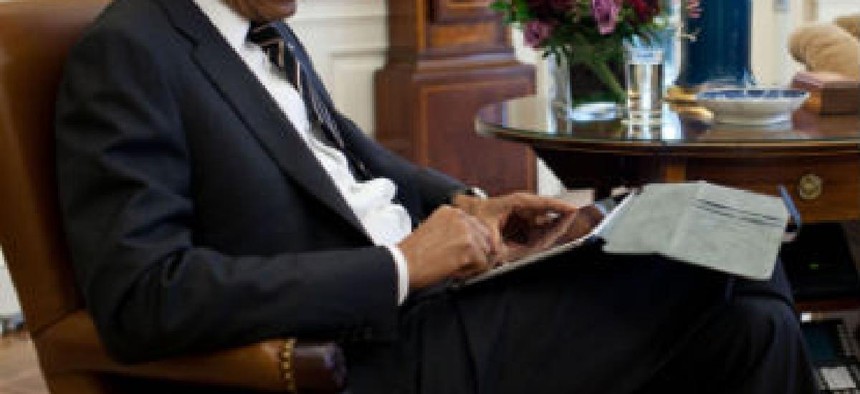A wish list for a digitized President's Daily Brief

Leading technologists argue that a paper-based briefing can no longer meet the president's information needs.

In this January 2012 photo, President Barack Obama is shown receiving a portion of the President's Daily Brief via tablet computer. C. Lawrence Meador and Vinton G. Cerf argue that a fully digitized version could improve significantly on the traditional paper-based version. (Official White House Photo by Pete Souza)
What: "Rethinking the President’s Daily Intelligence Brief," by C. Lawrence Meador and Vinton G. Cerf. Published in the CIA's quarterly journal, Studies in Intelligence
Why: The President's Daily Brief (PDB) is one of the most fussed-over documents in government. Historically, it is a printed document with up-to-the-moment threat information and foreign intelligence presented in person to the president by a top intelligence official, often the CIA director. The filtering of intelligence and analysis for the president's consumption is a coveted task. Over the years, the PDB "has been seen as a means for the [intelligence community] and its leaders to earn the confidence of presidents and their administrations and to offer a mechanism for presidents to provide feedback and tasking," the authors write.
Recently, the authors were involved in an experimental test of digitizing the PDB. Their findings and their survey of senior intelligence officials and White House customers show how delivering the PDB on a computer tablet could enrich the quality of the briefing, making it more visual, interactive and analytical.
Meador and Cerf envision the updated PDB as a platform through which the president could access actionable intelligence required in decision-making -- a service that has the daily briefing as an outer layer, but is dynamically updated via trusted agency feeds that can be queried, and that connects to other communications, such as email. While the authors don't advocate wider distribution of the PDB, they suggest that reimagining the briefing as an interactive platform could have broader implications for both customers and producers of intelligence.
Ideally, a PDB tablet would create a "curatorial" model in which the president interacts with intelligence to produce insight and action, replacing the "editorial" model under which briefers decide what the president should see. It should enable users to directly task intelligence officers and perhaps even military leaders and diplomats with actions to be taken.
Data visualization can also support decision making. The authors envision a graphical layer with augmented-reality tools that draw on a combination of governmental and commercial mapping and analytics tools to provide the PDB recipient with key data, trend information and projection.
The authors recommend that a PDB tablet should be owned by the principal, not delivered by a briefer. But interactions with the president should be led by the briefer, who might hold the device, or "drive" what's on the display using a connected device. It should be connected and updated via a private cloud that links to intelligence community sources via a one-way connection. The government should own the operating software. Material should be searchable, and it should access finished intelligence product and open-source material, such a press reports. However, the report does not advocate giving the PDB recipient access to raw intelligence sources, "as the potential hazards will often far outweigh benefits." Rigorous access control should include a biometric signature or token, "if feasible among this challenging user community." The authors also advocate a self-destruct feature, perhaps keyed to an accelerometer.
Verbatim: "The largest challenges to implementing such shifts will be making adjustments to the PDB process and the culture that now governs the relationship between intelligence officials and senior leaders. In making these changes, the IC has the potential to move from a model of providing primarily finished analytic products -- in relatively staged, controlled interactions—to a new model of engaging in dynamic relationships between policymaker and intelligence officer, a model in which sources are referred to, key insights continuously updated, and feedback provided more comprehensively."
NEXT STORY: 'To purge or not to purge'






